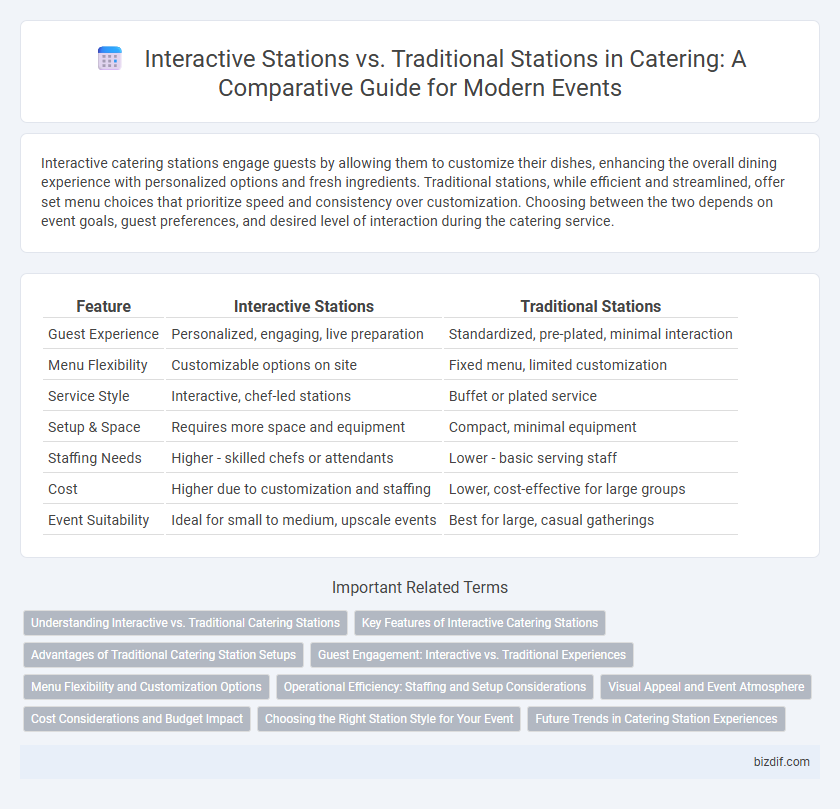Interactive catering stations engage guests by allowing them to customize their dishes, enhancing the overall dining experience with personalized options and fresh ingredients. Traditional stations, while efficient and streamlined, offer set menu choices that prioritize speed and consistency over customization. Choosing between the two depends on event goals, guest preferences, and desired level of interaction during the catering service.
Table of Comparison
| Feature | Interactive Stations | Traditional Stations |
|---|---|---|
| Guest Experience | Personalized, engaging, live preparation | Standardized, pre-plated, minimal interaction |
| Menu Flexibility | Customizable options on site | Fixed menu, limited customization |
| Service Style | Interactive, chef-led stations | Buffet or plated service |
| Setup & Space | Requires more space and equipment | Compact, minimal equipment |
| Staffing Needs | Higher - skilled chefs or attendants | Lower - basic serving staff |
| Cost | Higher due to customization and staffing | Lower, cost-effective for large groups |
| Event Suitability | Ideal for small to medium, upscale events | Best for large, casual gatherings |
Understanding Interactive vs. Traditional Catering Stations
Interactive catering stations offer a dynamic experience where guests customize dishes on demand, enhancing engagement and personalization. Traditional catering stations provide pre-prepared selections that emphasize efficiency and consistency, ideal for large events requiring quick service. Understanding the distinction helps event planners select catering styles that best match guest preferences and event logistics.
Key Features of Interactive Catering Stations
Interactive catering stations offer personalized food experiences by allowing guests to customize their dishes in real-time, enhancing engagement and satisfaction. These stations often feature live cooking, diverse ingredient options, and skilled chefs who prepare meals on demand, ensuring freshness and tailored flavor profiles. Unlike traditional stations with fixed menus, interactive setups adapt to dietary preferences and create dynamic social interactions that elevate event appeal.
Advantages of Traditional Catering Station Setups
Traditional catering station setups offer a structured and efficient flow that simplifies food service and reduces wait times by clearly designating specific areas for each course or dish. These stations provide consistent presentation standards and streamline staff coordination, ensuring quality control and timely replenishment. Their familiarity enhances guest comfort and expectation management, making them ideal for events prioritizing reliability and classic dining experiences.
Guest Engagement: Interactive vs. Traditional Experiences
Interactive catering stations enhance guest engagement by offering personalized food preparation and real-time interaction with chefs, creating memorable dining experiences. Traditional stations provide a consistent and efficient service but often lack the dynamic and immersive qualities that captivate guests. The increased sensory involvement in interactive setups fosters socializing and satisfaction, making them ideal for events focused on guest participation.
Menu Flexibility and Customization Options
Interactive catering stations offer superior menu flexibility and extensive customization options, allowing guests to personalize dishes with a variety of fresh ingredients and cooking styles. Traditional stations typically feature fixed menus with limited customization, restricting guest choices and potentially reducing satisfaction. By incorporating interactive elements, caterers can adapt to diverse dietary preferences and create a more engaging dining experience.
Operational Efficiency: Staffing and Setup Considerations
Interactive catering stations streamline operational efficiency by reducing the need for large staffing teams, as guests actively participate in customizing their meals. These stations often require minimal setup time compared to traditional buffet lines, which demand extensive arrangement and continuous staff oversight to replenish and serve dishes. By optimizing labor allocation and setup processes, interactive stations enable caterers to manage events more effectively while enhancing guest engagement.
Visual Appeal and Event Atmosphere
Interactive catering stations enhance visual appeal by showcasing chefs preparing food live, creating a dynamic and engaging atmosphere that draws guest attention. Traditional stations offer a polished, organized presentation but lack the vibrant energy and personalized experience provided by interactive setups. The visual stimulation from interactive stations elevates event ambiance, making gatherings feel more lively and memorable.
Cost Considerations and Budget Impact
Interactive catering stations often incur higher initial costs due to the need for specialized equipment and on-site staff, impacting the overall budget significantly. Traditional stations generally involve lower expenses, with simpler setups and less labor, making them more cost-effective for larger events or tighter budgets. Budget planning should weigh the added experiential value of interactive stations against the more predictable and manageable costs of traditional catering options.
Choosing the Right Station Style for Your Event
Interactive catering stations elevate guest engagement through customizable food options and live chef demonstrations, creating a memorable dining experience. Traditional stations offer streamlined service with pre-prepared dishes, ideal for large events seeking efficiency and consistency. Selecting the right station style depends on event size, guest preferences, and the desired level of interaction to ensure optimal satisfaction.
Future Trends in Catering Station Experiences
Interactive catering stations utilize cutting-edge technology such as touchless ordering, augmented reality menus, and live chef demonstrations to create immersive guest experiences, setting new standards for engagement and customization. Traditional stations, while reliable, often lack the dynamic interactivity and personalized service that modern consumers increasingly demand. Future trends emphasize hybrid setups that blend the efficiency of traditional formats with innovative interactive elements to enhance food presentation, hygiene, and real-time customization.
interactive stations vs traditional stations Infographic

 bizdif.com
bizdif.com